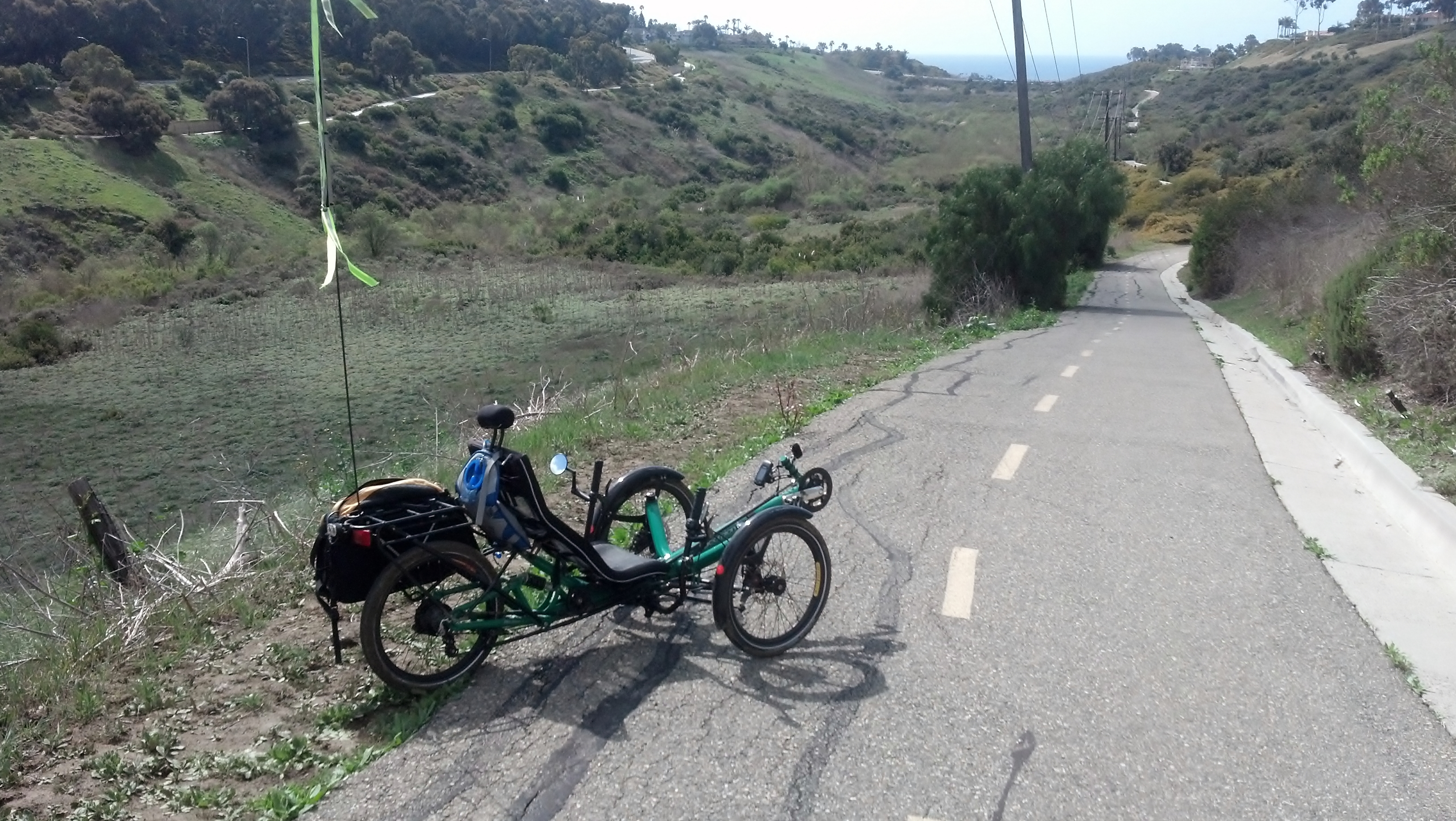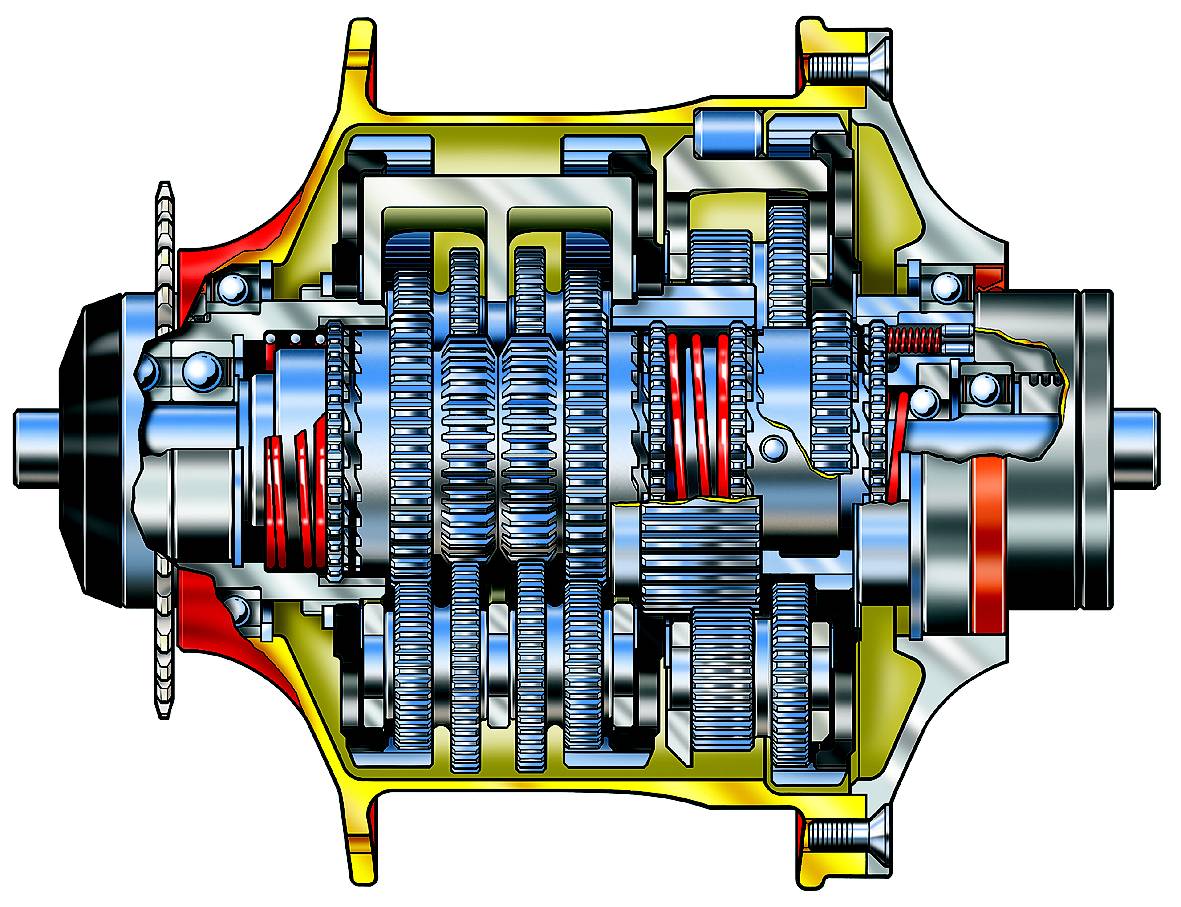This is the first of a 4 part series which discusses the equipment and gear I have chosen for going on tour with my trike.
My Trike And The Components That Make It Special
I built my trike to be as trouble-free and maintenance free as possible. I certainly don’t want the bike to break down many miles away from home. When I am home, I want to spend my precious free time riding my trike, not performing maintenance and/or making adjustments to it.
The Trike Itself
I ride a trike make by a company in Germany called HP Velotechnik . It is the Scorpion FS model. The FS in the model name stands for “Full Suspension” – that means it has suspension on both the front and rear wheels. Rough roads, dirt roads and bumpy sidewalks are much more comfortable with a suspension system on the trike. One rides the trike by sitting back in the comfy mesh seat and putting your feet up in front of you on the pedals – this is the recumbent position. The seat supports your butt, back and shoulders. It’s like a rolling lawn chair!
This particular trike model is tailor-made for touring. It’s made with big, beefy aluminum tubes that can hold up to lots of bashing about on a difficult ride. This trike is often called “The SUV of recumbent trikes” – it can easily carry me and all my heavy gear for many miles of trouble-free riding.

Drive Train: Pedals – Gearing – Wheels – Tires
Pedals and Shoes
The most critical interface on any bike’s drive train is between the bike and the engine (the rider). This occurs at the pedals of the trike and the feet of the rider. The pedals on my trike are Shimano PD-M540. These are ‘clip less’ pedals, which means that the pedals attach to the rider’s shoes via a set of cleats on the bottom of the shoe. This system allows the rider to push down on the pedal during the down stroke, and pull up on the pedal during the upstroke, generating much more efficiency while riding.
Another advantage of clip-less pedals is that they keep your feet attached to the pedals until you want to disengage them. Without clip-less pedals, it is possible for a rider to get injured if her feet are accidentally knocked off the pedals while the trike is moving, If the rider’s feet contact the ground, it is possible for the trike to roll forward over the rider’s feet and legs causing significant injury. This phenomenon, known as ‘leg-suck’, is a risk than is reduced dramatically via the use of clip-less pedals. With these pedals and shoes, my feet stay stuck to the pedals without any extra effort on my part,
I use these pedals paired with a set of Pearl Izumi mountain bike shoes. When I built the trike, I took the pedals from my earlier bikes. I have used these pedals and shoes together for many, many years. The shoes are getting old and pretty ratty looking, but they work fine and they are very comfortable. I do not suffer from “hot foot”, or numbness in the feet, that many recumbent riders complain about on long rides. I have done lots of long rides, and have gotten sore and tired in many ways, but my feet have always held up fine using this combination of shoe and pedal. This is such a critical part of the bike that I am reluctant to mess with it. If it ain’t broke, don’t fix it! So I’ll continue to ride in them until my ratty old shoes start to fall apart.
Cranks and Front Gears
To transfer the power of the rider to the chain, I have installed the Schlumpf Speed Drive on the front of my drive train. An internal gear system, this drive replaces a traditional front derailleur and two chain rings. Instead, it has a planetary gearing system that is shifted between a direct drive 1:1 ratio and a high speed 1:1.65 ratio. Shifting is accomplished by pressing the small button on the side of the drive using your heel. Click it to the right for the 1:1 drive mode, to the left for the 1:1.65 drive mode. This configuration gives me the equivalent of 37 tooth and 61 tooth chain-rings.

Rear Hub
The heart of the drive train on my trike is the Rohloff Speedhub 500/14 14 speed internal hub built into my 20″ rear wheel. This internal hub provides me with 14 different gears, each spaced precisely 13.6% apart from the adjacent gear. The total gear range of the hub is an amazing 526%.

The Rohloff Hub is an incredible piece of mechanical engineering. Packed into a really small space. The interior of the hub looks almost jewel-like in its intricacy. But this look is deceiving! Because it is completely sealed, it provides unparalleled reliability and durability. There is almost no adjustment or maintenance required for this hub. It’s not going to break down and leave me stranded in the middle of nowhere. When I purchased my hub in 2011, the manufacturer claimed that they had never had a hub failure reported to them. Since then, they have stated a handful of failures – but they have all been hubs ridden for 100’s of thousands of kilometers and were much abused during that time. Under normal use, and with appropriate (very minimal) maintenance, this thing is bulletproof!

Gearing
The Rohloff hub has a 16 tooth cog mounted on it. Together with the 37 tooth chain-ring on the Schlumpf Speed Drive, this combination gives my trike a gear range of 1315%. That is enormous!
Gearing calculations on bicycles are typically made in terms of “gear-inches”. This system of gearing calculations dates back to the days of the high-wheel bicycles. “Gear Inches” is the equivalent diameter of the drive wheel on a high-wheel bicycle. When chain-drive “safety” bikes were introduced, the same system was used, multiplying the drive wheel diameter by the sprocket ratio.
For those of you readers that are complete bike weenie gear heads (like me), here is the gear inch development chart for my bike.
Schlumpf - Rohloff Development Chart (Gear Inches)
Development Chart for Schlumpf Speed Drive (37 t cog) Paired With Rohloff Speed Hub (16t cog) on Recumbent Trike with 406 wheels (in Gear Inches)| Rohloff Gear | Schlumpf Direct Mode (1:1) | Schlumpf Speed Mode (1:1.65) |
|---|---|---|
| 1 | 12.42 | 20.50 |
| 2 | 14.20 | 23.42 |
| 3 | 15.97 | 26.35 |
| 4 | 18.19 | 30.01 |
| 5 | 20.41 | 33.67 |
| 6 | 23.51 | 38.79 |
| 7 | 26.62 | 43.92 |
| 8 | 30.17 | 49.77 |
| 9 | 34.16 | 56.36 |
| 10 | 39.04 | 64.41 |
| 11 | 44.36 | 73.20 |
| 12 | 50.57 | 83.44 |
| 13 | 57.23 | 94.42 |
| 14 | 65.21 | 107.60 |
The low gear of 12.42 gear inches is low enough that I can easily climb any hill I have ever encountered, even when I am carrying many pounds of heavy equipment. I may go up slowly, but I will go up without getting out and pushing the trike. The high gear of 107 gear inches means I can pedal the bike to speeds approaching 30 MPH on downhills. I can go faster on long downhills because gravity will keep me accelerating. That’s plenty fast enough for me when on tour – especially since I am carrying a heavy load.
Tires
The last critical interface – between the trike and the road – is made by the tires. I use Marathon Plus tires manufactured by Schwalbe (size 47-406). I chose these tires because they are tough. Many trike riders choose lighter, faster tires. But I have used the same tires on my trike for nearly 25,000 miles, and I have only gotten a couple of flat tires. I need to hit something really unusual to puncture these tires – like on this training ride. Normal road hazards like steel belt threads, glass bits, goat-head thorns, etc, won’t touch this tire, I don’t like fixing flat tires when I’m riding. I really don’t like fixing flat tires when I’m out on a tour. There are lighter tires, there are faster tires, there are certainly cheaper tires, but these are the most flat proof tires I know about.
What’s Next?
So that’s how I make the trike go. But,I need to be able to stop, and steer, and find places I want to go. And to stay safe, I need to find ways to make myself as visible as possible to the motorists I share the roads with. So next up is part II – safety and navigation….


